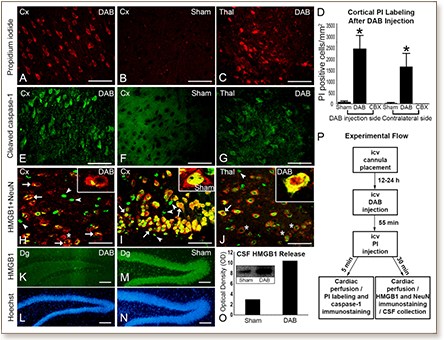
Objective: Glycogen in astrocyte processes contributes to maintenance of low extracellular glutamate and K+ concentrations around excitatory synapses. Sleep deprivation (SD), a common migraine trigger, induces transcriptional changes in astrocytes, reducing glycogen breakdown. We hypothesize that when glycogen utilization cannot match synaptic energy demand, extracellular K+ can rise to levels that activate neuronal pannexin-1 channels and downstream inflammatory pathway, which might be one of the mechanisms initiating migraine headaches.
Methods: We suppressed glycogen breakdown by inhibiting glycogen phosphorylation with 1,4-dideoxy-1,4-imino-D-arabinitol (DAB) and by SD.
Results: DAB caused neuronal pannexin-1 large pore opening and activation of the downstream inflammatory pathway as shown by procaspase-1 cleavage and HMGB1 release from neurons. Six-hour SD induced pannexin-1 mRNA. DAB and SD also lowered the cortical spreading depression (CSD) induction threshold, which was reversed by glucose or lactate supplement, suggesting that glycogen-derived energy substrates are needed to prevent CSD generation. Supporting this, knocking down the neuronal lactate transporter MCT2 with an antisense oligonucleotide or inhibiting glucose transport from vessels to astrocytes with intracerebroventricularly delivered phloretin reduced the CSD threshold. In vivo recordings with a K+-sensitive/selective fluoroprobe, Asante Potassium Green-4, revealed that DAB treatment or SD caused a significant rise in extracellular K+ during whisker stimulation, illustrating the critical role of glycogen in extracellular K+ clearance.
Interpretation: Synaptic metabolic stress caused by insufficient glycogen-derived energy substrate supply can activate neuronal pannexin-1 channels as well as lower the CSD threshold. Therefore, conditions that limit energy supply to synapses (eg, SD) may predispose to migraine attacks, as suggested by genetic studies associating glucose or lactate transporter deficiency with migraine.
